The life and the history of Thomas F. Meagher
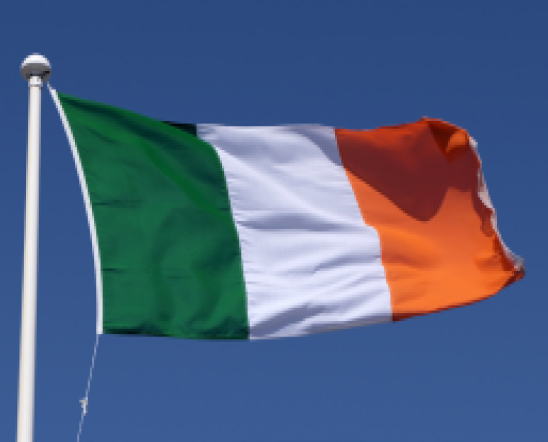
Early Life
Thomas Francis Meagher was born in what is now The Granville Hotel, Waterford, Ireland in 1823; then the family home of his mother Alicia Quan and father Thomas Meagher, a union of two of the most prominent merchant families in Waterford. His father traded between Waterford and Newfoundland, Canada.
He was educated in Clongowes Wood College from 1833-1839 then by fellow Jesuits at Stonyhurst, Lancashire from 1839-1843. At the age of 24 he put himself forward for election as an MP to the House of Commons.
Delegate to French Revolutionaries
Thomas Francis Meagher was sent as a delegate to French Revolutionaries in 1848, but returned from Paris with no weapons and no money; however he did return with a symbol that was to prove more powerful than either – a flag modelled on the French tricolour and comprising three vertical bands – green symbolising the south, orange the north, and white for peace between these two traditionally warring factions.
When Thomas F. Meagher flew the tricolour from the window of 33 The Mall, The Wolfe Tone Club in Waterford it was a display of national identity.
In presenting the tricolour to the Irish people on his return from Paris Meagher outlined this philosophy when he stated that:
“The white in the centre signifies a lasting truce between the orange and the green, and I trust that beneath its folds the hands of the Irish Protestant and the Irish Catholic may be clasped, in generous and heroic brotherhood.”
During the Easter Rising in 1916 it was flown from the GPO in Dublin and Meagher’s tricolour became the flag of the Republic of Ireland.
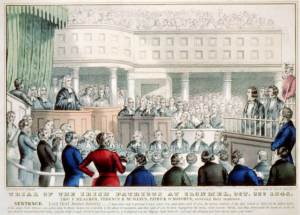
Australia 1849-1852
Following the failed rebellion of 1848 and for his part in the rising of 1848 Thomas Francis Meagher was put on trial for high treason and on July 29th 1849 Meagher was sentenced to be hung, drawn and quartered.
“Your Honour if you do not sentence me to death I will try again”.
The death sentence was commuted to transportation for life to Van Diemen’s Land (now Tasmania, Australia) and he was banished with other key members of the Young Ireland movement to Tasmania. Writing his last letter from Richmond prison in 1849, Meagher prophetically described the Ireland of the future.
“Never was there a country so utterly downcast, so depressed, so pitiful, so spiritless. Yet I do not, could not, despair of her regeneration. Nations do not die in a day. Their lives are reckoned by generations, and they encompass centuries. Their vitality is inextinguishable.”
This banishment to a distant land failed to break the spirit of the movement. Meagher and his comrades continued to meet in secret. Meagher settled and married in Tasmania but on January 3rd, 1852, with the help of supporters in America, he escaped. He slipped aboard the ship ‘Elizabeth Thompson’ and arrived in New York four months later via Brazil to a hero’s welcome from his fellow-countrymen.
With the transportation of the 1848 rebels in 1849, Meagher’s tricolour was more or less forgotten until retrieved in the years leading up to and during the 1916 rising when a clear break took place in national symbolism; most visibly manifested in the national flag.
American Civil War
In 1861 with the outbreak of the American Civil War he joined the 69th Regiment and subsequently he fused together five regiments of mainly Irish-Americans to form the famous Irish Brigade.
Following the war Meagher was appointed by Abraham Lincoln as Secretary and acting Governor of Montana, where a large statue of Thomas Francis Meagher stands before the Capitol Building in Helena.
At a St. Patrick’s Day speech by fellow Irishman and Montana U.S. House Rep Martin Maginnis in 1869, Maginnis called for a statue of Meagher to be erected and the state’s large Irish population obliged.
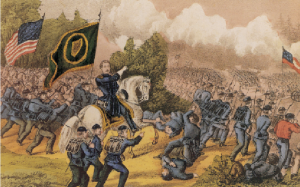
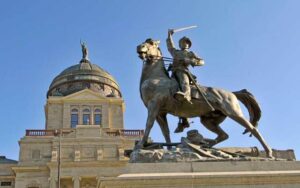
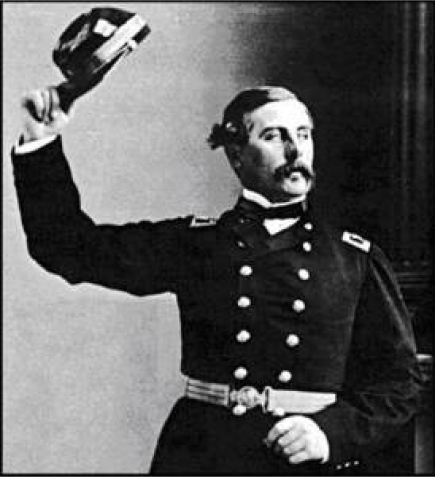
The Gold Medal In New York 1863
To Meagher, reputation and honour were inextricably linked. After the failed Irish revolution of 1848 “my character is now more dear to me than my life” and if not withdrawn “will deprive me of all that remains to me – my reputation, my honour and my fame.”
And in New York in 1863, while being presented with a gold medal for his contribution to the war effort Meagher stated that the Irish soldier never once lost sight of the inviolability of the magnificent symbolism of the stars and stripes. Throughout the war, whatever his faults, and there were many, Meagher was consistent in his support for the President and the Constitution which supported that institution, as well as the liberty and freedoms it protected.
“Restrict the freedom of a nation and you check all those passions which make it noble and progressive.” the nation that does not possess the power to shape its own destiny “will have no heart, no courage, no ambition.”
Meagher died mysteriously near Fort Benton in 1867. Sometime in the early evening July, 1st 1867 Meagher is said to have gone overboard a steamboat into the Missouri River. There is still much debate whether his death was an accident or foul play. His body was never recovered.
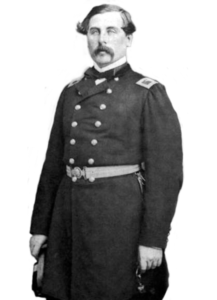
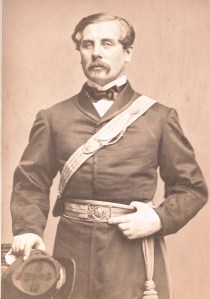
JFK’s Irish Visit June 1963
President John F. Kennedy when addressing the combined houses of the Irish Parliament John F. Kennedy during his visit to Ireland on June 28th 1963 spoke about Thomas F. Meagher and the 69th regiment of the “Irish Brigade”.
It is truly extraordinary that the man associated with the creation of the Irish tricolour should be resurrected in modern consciousness by an equally enduring flag resonant of bravery, freedom and democracy in the most powerful nation in the world.
“The 13th day of September, 1862, will be a day long remembered in American history. at Fredericksburg, Maryland. Thousands of men fought and died on one of the bloodiest battlefields of the American Civil War. One of the most brilliant stories of that day was written by a band of 1,200 men who went into battle wearing a green sprig in their hats. They bore a proud heritage and a special courage, given to those who had long fought for the cause of freedom, I am referring, of course, to the Irish Brigade. General Robert E. Lee, the great military leader of the Southern Confederate Forces, said of this group of men after the battle: “the gallant stand which this bold brigade made on the heights of Fredericksburg is well known. Never were men so brave. they ennobled their race by their splendid gallantry on that desperate occasion. Their brilliant, though hopeless, assaults on our lines excited the hearty applause of our officers and soldiers”.
Of the 1,200 men who took part in that assault, 280 survived the battle. The Irish Brigade was led into battle on that occasion by Brigadier General Thomas F. Meagher, who had participated in the unsuccessful Irish uprising of 1848, was captured by the British and sent in a prison ship to Australia, from whence he finally came to America. In the fall of 1862, after serving with distinction and gallantry in some of the toughest fighting of this most bloody struggle, the Irish brigade was presented with a new set of flags. In the city ceremony, the city chamberlain gave them the motto “the union, our country, and Ireland forever.” Their old ones having been torn to shreds by bullets in previous battles, Captain Richard McGee took possession of these flags on September 2nd in New York City and arrived with them at the battle of Fredericksburg and carried them in the battle.wearing a green sprig in their hats. They bore a proud heritage and a special courage, given to those who had long fought for the cause of freedom. I am referring, of course, to the Irish brigade. General Robert E. Lee, the great military leader of the southern confederate forces, said of this group of men after the battle: “the gallant stand which this bold brigade made on the heights of Fredericksburg is well known. Never were men so brave. They ennobled their race by their splendid gallantry on that desperate occasion. Their brilliant, though hopeless, assaults on our lines excited the hearty applause of our officers and soldiers”.
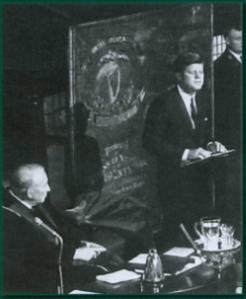
“Today, in recognition of what these gallant Irishmen and what millions of other Irish have done for my country, and through the generosity of the fighting 69th, I would like to present one of these flags to the people of Ireland.”
John F. Kennedy, 35th President of the United States.

